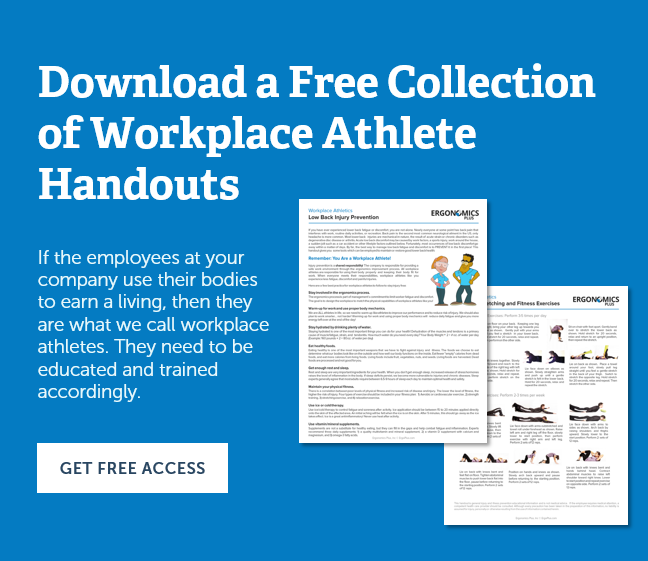Editor’s Note: Injury prevention and wellness handouts are an effective (and inexpensive) way to educate and motivate employees to use good work practices and take care of their bodies.
Scroll to the bottom of this post for the free Wellness Handout PDF file.
Health and Fitness for Work and Life
We are all athletes in life! Staying healthy and fit helps you prevent painful movement system disorders and improves your quality of life.
The 6-Step Health and Fitness Checklist for the Industrial Athlete
- Hydration
- Nutrition
- Fitness
- Rest and Sleep
- Ice or Cold Therapy
- Vitamin and Mineral Supplements
1. Hydration
Drinking plenty of water is one of the most important things you can do for your health! Healthy muscles are comprised of at least 70% water. Dehydration of the muscles and tendons is a primary cause of muscle fatigue, strain, tendonitis, and other disorders of the movement system. How much water do you need every day? Your Body Weight ÷ 2 = # oz. of water per day (Example: 160 pounds ÷ 2 = 80 oz. of water per day)
2. Nutrition
Healthy eating is one of the most important weapons that we have to fight against injury and illness. The foods we choose to eat determine what our bodies look like on the outside and how well our body functions on the inside. Eat fewer “empty” calories from dead foods, and eat more calories from living foods. Living foods include fruit, vegetables, nuts, and seeds. Living foods are harvested. Dead foods are processed and not good for you.
3. Fitness
We need to maintain our physical fitness levels to prevent injuries and illness. There’s a correlation between poor levels of physical fitness and increased risk of disease and injury. The lower the level of fitness, the higher the risk of injury. Four types of exercise for your fitness plan: 1) Aerobic or cardiovascular exercise, 2) strength training, 3) stretching exercise, and 4) relaxation exercise.
4. Rest and Sleep
Adequate amounts of rest and sleep are very important ingredients for our health. When we don’t get enough sleep, increased release of stress hormones raises the level of inflammation in the body. If rest and sleep deficits persist, we become more vulnerable to injuries and chronic diseases. Sleep experts generally agree that most adults require between 6.5-9 hours of sleep each day to maintain optimal health and safety.
5. Ice or Cold Therapy
Workplace athletes can use ice or cold therapy to control fatigue and soreness after activity. Ice application should be between 15 to 20 minutes applied directly onto the skin of the affected area. An initial aching will be felt when the ice is on the skin. After 5 minutes, this should go away as the ice takes effect. Ice is a great anti-inflammatory! Never use heat after activity.
6. Vitamin and Mineral Supplements
Vitamin & mineral supplements are not a substitute for healthy eating, but they can fill in the gaps and help combat fatigue and inflammation. Experts recommend three daily supplements: 1) a quality multivitamin and mineral supplement, 2) a vitamin D supplement with calcium and magnesium, and 3) omega-3 fatty acids
Key Points:
- We are all athletes in life. Staying healthy and fit helps you prevent painful movement system disorders and improves your quality of life.
- Remember that the way to prevent MSDs is to decrease fatigue and increase recovery – staying healthy and fit will do both at the same time.
- As a valued team member, your job is to help your team win by staying healthy, fit and on the field. You can’t do that if you’re sidelined with an injury!
